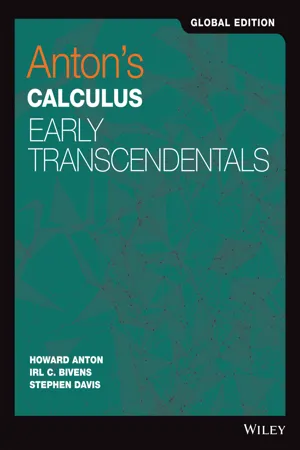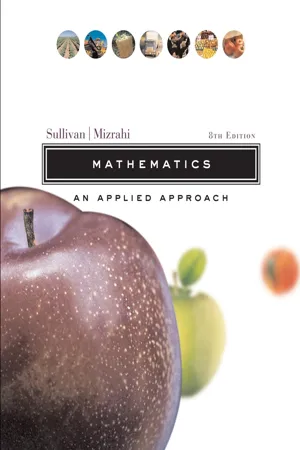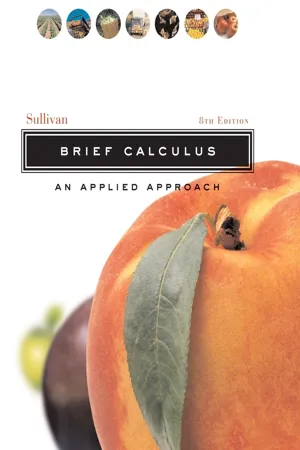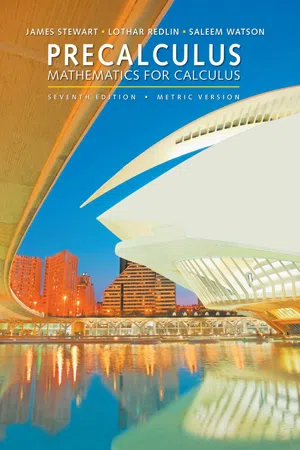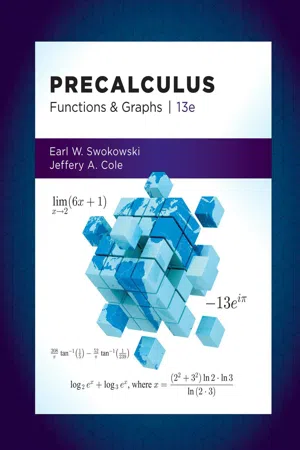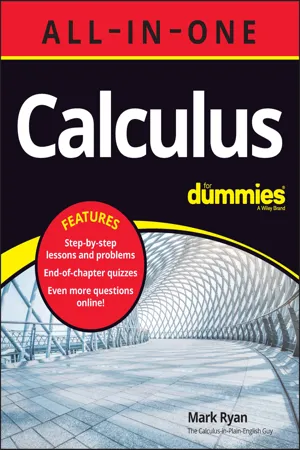Mathematics
Finding Limits
Finding limits in mathematics involves determining the value that a function approaches as the input approaches a certain value. This concept is essential for understanding the behavior of functions near specific points and is a fundamental aspect of calculus. By finding limits, mathematicians can analyze the behavior of functions and solve various problems in calculus and other areas of mathematics.
Written by Perlego with AI-assistance
Related key terms
1 of 5
10 Key excerpts on "Finding Limits"
- eBook - PDF
Anton's Calculus
Early Transcendentals
- Howard Anton, Irl C. Bivens, Stephen Davis(Authors)
- 2018(Publication Date)
- Wiley(Publisher)
A 1 A 2 A 1 A 2 A 3 Figure 1.1.6 x y a b (b) x y a b (c) x y a b (a) Figure 1.1.7 DECIMALS AND LIMITS Limits also arise in the familiar context of decimals. For example, the decimal expansion This figure shows a region called the Mandelbrot Set. It illustrates how complicated a region in the plane can be and why the notion of area requires careful definition. Andreas Nilsson/Shutterstock of the fraction 1 3 is 1 3 = 0.33333 … (3) in which the dots indicate that the digit 3 repeats indefinitely. Although you may not have thought about decimals in this way, we can write (3) as 1 3 = 0.33333 … = 0.3 + 0.03 + 0.003 + 0.0003 + 0.00003 + ⋯ (4) which is a sum with “infinitely many” terms. As we will discuss in more detail later, we interpret (4) to mean that the succession of finite sums 0.3, 0.3 + 0.03, 0.3 + 0.03 + 0.003, 0.3 + 0.03 + 0.003 + 0.0003, … gets closer and closer to a limiting value of 1 3 as more and more terms are included. Thus, limits even occur in the familiar context of decimal representations of real numbers. LIMITS Now that we have seen how limits arise in various ways, let us focus on the limit concept itself. The most basic use of limits is to describe how a function behaves as the independent variable approaches a given value. For example, let us examine the behavior of the function f (x) = x 2 − x + 1 for x-values closer and closer to 2. It is evident from the graph and table in Figure 1.1.8 that the values of f (x) get closer and closer to 3 as values of x are selected closer and closer to 2 on either the left or the right side of 2. We describe this by saying that the “limit of x 2 − x + 1 is 3 as x approaches 2 from either side,” and we write lim x →2 (x 2 − x + 1) = 3 (5) - eBook - PDF
Mathematics
An Applied Approach
- Michael Sullivan, Abe Mizrahi(Authors)
- 2017(Publication Date)
- Wiley(Publisher)
We may describe the meaning of as follows: For all values of x approximately equal to c, with x c, the corresponding value f (x) is approximately equal to N. lim x c f (x) N lim x c f (x) N Finding Limits Using Tables and Graphs 677 A L O O K B AC K , A L O O K F O RWA R D In Chapter 10 we defined a function and many of the proper- ties that functions can have. In Chapter 11 we discussed class- es of functions and properties that the classes have. With this as background we are ready to study the limit of a function. This concept is the bridge that takes us from the mathematics of algebra and geometry to the mathematics of calculus. Calculus actually consists of two parts: the differential cal- culus, which we discuss in Chapters 13 and 14 and the integral calculus, discussed in Chapters 15 and 16. In Chapter 17 we study the calculus of functions of two or more variables. In differential calculus we introduce another property of functions, namely the derivative of a function. We shall find that the derivative opens up a way for doing many applied problems in business, economics, and social sciences. Many of these applications involve an analysis of the graph of a function. PREPARING FOR THIS SECTION Before getting started, review the following: 12.1 Finding Limits Using Tables and Graphs > Evaluating Functions (Chapter 10, Section 10.2, pp. 550 – 551) > Piecewise-defined Functions (Chapter 10, Section 10.4, pp. 583 – 585) > Library of Functions (Chapter 10, Section 10.4, pp. 579 – 583) OBJECTIVES 1 Find a limit using a table 2 Find a limit using a graph 678 Chapter 12 The Limit of a Function From Table 1, we infer that as x gets closer to 3 the value of f (x) 5x 2 gets closer to 45. That is, ◗ When choosing the values of x in a table, the number to start with and the subse- quent entries are arbitrary. However, the entries should be chosen so that the table makes it clear what the corresponding values of f are getting close to. - eBook - PDF
Brief Calculus
An Applied Approach
- Michael Sullivan(Author)
- 2021(Publication Date)
- Wiley(Publisher)
In Chapter 8 we study the calculus of nctions of two or more variables. In differential calculus we introduce another property of nctions, namely the derivative of a function. We shall d that the derivative opens up a way r doing many applied problems in business, economics, and social sciences. Many of these applications involve an analysis of the graph of a nction. m Finding Limits Using Tables and Graphs PREPARING FOR THIS SECTION Before getting started, review the following: > Evaluating Functions (Chapter 1. Section 1.2. pp. 108-112) > Piecewise-defined Functions (Chapter 1. Section 1.4. pp. 143-145) OBJECTIVES 1 Find a limit using a table 2 Find a limit using a graph > Library of Functions (Chapter 1. Section 1.4. pp. 137-143) The idea of the limit of a nction is what connects algebra and geometry to calculus. In working with the limit of a nction, we encounter notation of the rm limf(x) = N xc This is read as "the limit of f(x) as x approaches c equals the number N" Here f is a nction defined on some open interval containing the number c; f need not be defined at c, however. may describe the meaning of lim f(x) = N as llows: xc For all values of x approximately equal to c, with x c, the corresponding value f(x) is approximately equal to N 238 Chapter 3 The Limit of a Function TABLE 2 X Y1 2.9 .71 2.99 .97 2199 .997 3.11 .3 31 .3 .301 X= EXAMPLE 1 Another description of lim f(x) = N is xc As x gets closer to c, but remains unequal to c, the corresponding value of f(x) gets closer to N. bles generated with the help of a calculator are usel r Finding Limits. Finding a Limit Using a Table Find: lim(5x 2 ) x3 SOLUTION Here f(x) = 5x2 and c = 3. We choose values of x close to 3, arbitrarily starting with 2.99. Then we select additional numbers that get closer to 3, but remain less than 3. Next we choose values of x greater than 3, starting with 3.01, that get closer to 3. - No longer available |Learn more
- James Stewart, Lothar Redlin, Saleem Watson(Authors)
- 2016(Publication Date)
- Cengage Learning EMEA(Publisher)
In this chapter we study the central idea underlying calculus: the concept of a limit. Calculus is used in modeling numerous real-life phenomena, particularly situations that involve change or motion. Limits are used in finding the instantaneous rate of change of a function as well as the area of a region with curved boundary. You will learn in calculus that these two apparently different problems are closely related. In this chapter we see how limits allow us to solve both problems. In Chapter 2 we learned how to find the average rate of change of a function. For example, to find the average speed, we divide the total distance traveled by the total time. But how can we find instantaneous speed—that is, the speed at a given instant? We can’t divide the total distance by the total time because in an instant the total distance traveled is zero and the total time spent traveling is zero! But we can find the average rate of change on smaller and smaller intervals, zooming in on the instant we want. In other words, the instantaneous speed is a limit of the average speeds. In this chapter we also learn how to find areas of regions with curved sides by using the limit process. 897 Limits: A Preview of Calculus 13 13.1 Finding Limits Numerically and Graphically 13.2 Finding Limits Algebraically 13.3 Tangent Lines and Derivatives 13.4 Limits at Infinity; Limits of Sequences 13.5 Areas FOCUS ON MODELING Interpretations of Area PF-(space1)/Alamy Copyright 2017 Cengage Learning. All Rights Reserved. May not be copied, scanned, or duplicated, in whole or in part. Due to electronic rights, some third party content may be suppressed from the eBook and/or eChapter(s). Editorial review has deemed that any suppressed content does not materially affect the overall learning experience. Cengage Learning reserves the right to remove additional content at any time if subsequent rights restrictions require it. - eBook - PDF
- G. M. Fikhtengol'ts, I. N. Sneddon(Authors)
- 2014(Publication Date)
- Pergamon(Publisher)
CHAPTER 3 THEORY OF LIMITS § 1. The limit of a function 26. Historical remarks. The concept of limit now enters into the whole of mathematical analysis and also plays an important part in other branches of mathematics. However (as the reader will see in Chapter 14), this concept was certainly not the basis of the differential and integral calculus at the time of their creation. The concept of a limit appears for the first time (essentially in the same form as it will be given below in Sec. 28) in the works of Wallist in his Arithmetic of Infinite Quantities (1655). Newton in the celebrated Mathematical Foundations of Natural Philosophy (1686-1687) announced his method of the first and last ratios (sums) in which the beginnings of the theory of limits can be seen. However, none of the great mathematicians of the eighteenth century tried to base the new calculus on the concept of limit and by doing so to meet the just criticism to which the calculus was subject*. In this respect Euler's views are characteristic; in the foreword to his treatise on Differential Calculus (1755) he clearly speaks of the limit but nowhere in the book makes use of this concept. The turning point in this problem is due to the Algebraic Analysis (1821) of Cauchy§ and his further publications, in which for the first time the theory of limits was developed; it was used by Cauchy as an effective means to a precise construc-tion of mathematical analysis. Cauchy's standpoint, which destroyed the mystique surrounding the foundations of analysis, was widely recognized. Strictly speaking, Cauchy's merit is shared also by other scholars—particularly Bolzano; in many cases his papers were prior to those of Cauchy and later mathe-maticians. They however were not known at the time and were remembered only after many decades. - eBook - PDF
Precalculus
Functions and Graphs
- Earl Swokowski, Jeffery Cole(Authors)
- 2018(Publication Date)
- Cengage Learning EMEA(Publisher)
The preceding limit can also be established by means of the definition of a limit of a function. We state these facts for reference in the next theorem. Techniques for Finding Limits 11.3 Theorem on Limits (1) lim x l a c 5 c (2) lim x l a x 5 a 808 CHAPTER 11 Limits of Functions Copyright 2019 Cengage Learning. All Rights Reserved. May not be copied, scanned, or duplicated, in whole or in part. Due to electronic rights, some third party content may be suppressed from the eBook and/or eChapter(s). Editorial review has deemed that any suppressed content does not materially affect the overall learning experience. Cengage Learning reserves the right to remove additional content at any time if subsequent rights restrictions require it. As we shall see, the limits in the preceding theorem can be used as build-ing blocks for Finding Limits of very complicated expressions. I L L U S T R A T I O N ■ lim x l 3 8 5 8 ■ lim x l 8 3 5 3 ■ lim x l Ï 2 x 5 Ï 2 ■ lim x l 2 4 x 5 2 4 Many functions can be expressed as sums, differences, products, and quotients of other functions. Suppose f and g are functions and L and M are real numbers. If f s x d l L and g s x d l M as x l a , we would expect that f s x d 1 g s x d l L 1 M as x l a . The next theorem states that this expectation is true and gives analogous results for products and quotients. We may state properties (3)–(7) above as follows: (3) The limit of a sum is the sum of the limits. (4) The limit of a product is the product of the limits. (5) The limit of a quotient is the quotient of the limits, provided the denomi-nator has a nonzero limit. (6) The limit of a constant times a function is the constant times the limit of the function. (7) The limit of a difference is the difference of the limits. Proofs for (3)–(5), based on the definition of a limit of a function, are given in Appendix V. - Mark Ryan(Author)
- 2023(Publication Date)
- For Dummies(Publisher)
This is the main focus of this chapter. These are the interesting limit problems, the ones that likely have infinitesimal holes, and the ones that are important for differential calculus — you see more of them in Chapter 9. With these real-deal limit problems (where plugging in often gives you 0 0 ), you can try four things: your calculator, general algebraic techniques, making a limit sandwich (a special alge- braic technique), and L’Hôpital’s rule (which is covered in Chapter 18). Figuring a limit with your calculator Your calculator is a great tool for understanding limits. It can often give you a better feel for how a limit works than the algebraic techniques can. A limit problem asks you to determine what the y-value of a function is zeroing in on as the x-value approaches a particular number. With your calculator, you can actually witness the process and the result. Say you want to eval- uate the following limit: lim x x x 5 2 25 5 . The plug-and-chug method doesn’t work because plug- ging 5 into x produces the undefined result of 0 0 . Let’s solve this limit problem with a calculator. I’ll go over two basic methods. A note about calculators and other technology: With every passing year, there are more and more powerful calculators and more and more resources on the Internet that can do calculus for you. One thing that allows these technologies to do calculus is that they can handle algebra (using CAS, a Computer Algebra System). Say you input x x 3 2 5 . These technologies can FOIL that expression and give you the algebraic answer of 2 15 2 x x . A calculator like the TI-Nspire, or any other calculator with CAS, or websites like Wolfram Alpha (www.wolfram alpha.com), can actually do the above limit problem, and all sorts of more difficult calculus problems, and give you the exact numerical or algebraic answer. 144 UNIT 3 Limits Older calculator models can’t do algebra or calculus in the real, precise, algebraic way.- eBook - PDF
- Laura R. Van Zoest(Author)
- 2003(Publication Date)
- Information Age Publishing(Publisher)
I thought that a determina-tion of a student’s typical use of technology and their personal understand-ing of limit might reveal links between the students’ preferred methods of solution and their particular understanding of the limit concept. I also thought that an examination of the accuracy of students’ solutions along with their personal concept images would provide evidence of whether stu-dents’ ability to determine limits using informal techniques with technol-ogy is good evidence that they understand the concept. I focused my work on two main questions: (1) What is the relationship between students’ solution methods and their conceptions of limit? and (2) What is the rela-tionship between students’ ability to successfully use technology to deter-mine limits and their conceptual understanding of limit? I believed that information with respect to these issues and answers to these questions could be important for calculus teachers to know. RESEARCH PROCEDURES The Context Our high school offers three levels of calculus: College Board Advanced Placement AB and BC Calculus courses and an Applied Calculus course. BC Calculus, the school’s highest level course, uses Thomas and Finney’s (1996) Calculus and maintains high expectations for mathematical rigor and proof. While they are not prohibited from using the calculator, BC students are not explicitly taught to use it for calculating limits. The methods they learn are all analytic, including epsilon-delta proofs. In BC 44 W. J. HARRINGTON Calculus, the idea of a limit is first defined in the following way: “Let f ( x ) be defined on an open interval about x 0 , except possibly at x 0 itself. If f ( x ) gets arbitrarily close to L for all x sufficiently close to x 0 , we say that f approaches the limit L as x approaches x 0 ” (Thomas & Finney, 1996, p. 55). BC Calculus students are also given a formal epsilon-delta definition. - eBook - PDF
Calculus
Late Transcendental
- Howard Anton, Irl C. Bivens, Stephen Davis(Authors)
- 2016(Publication Date)
- Wiley(Publisher)
The graphs of y = 1/(x + 1) and y = x/(x + 1) have horizontal asymptotes. 1.4 Limits (Discussed More Rigorously) 31 1.4 LIMITS (DISCUSSED MORE RIGOROUSLY) In the previous sections of this chapter we focused on the discovery of values of limits, either by sampling selected x-values or by applying limit theorems that were stated without proof. Our main goal in this section is to define the notion of a limit precisely, thereby making it possible to establish limits with certainty and to prove theorems about them. This will also provide us with a deeper understanding of some of the more subtle properties of functions. MOTIVATION FOR THE DEFINITION OF A TWO-SIDED LIMIT The statement lim x →a f (x) = L can be interpreted informally to mean that we can make the value of f (x) as close as we like to the real number L by making the value of x sufficiently close to a. It is our goal to make the informal phrases “as close as we like to L” and “sufficiently close to a” mathematically precise. To do this, consider the function f graphed in Figure 1.4.1a for which f (x) → L as x → a. For visual simplicity we have drawn the graph of f to be increasing on an open interval containing a, and we have intentionally placed a hole in the graph at x = a to emphasize that f need not be defined at x = a to have a limit there. Figure 1.4.1 Next, let us choose any positive number and ask how close x must be to a in order for the values of f (x) to be within units of L. We can answer this geometrically by drawing horizontal lines from the points L + and L − on the y-axis until they meet the curve y = f (x), and then drawing vertical lines from those points on the curve to the x-axis (Figure 1.4.1b). As indicated in the figure, let x 0 and x 1 be the points where those vertical lines intersect the x-axis. Now imagine that x gets closer and closer to a (from either side). - eBook - PDF
- Ron Larson, Bruce Edwards(Authors)
- 2018(Publication Date)
- Cengage Learning EMEA(Publisher)
EXPLORING CONCEPTS 65. Finding δ When using the definition of limit to prove that L is the limit of f (x) as x approaches c, you find the largest satisfactory value of δ. Why would any smaller positive value of δ also work? 66. Using the Definition of Limit The definition of limit on page 76 requires that f is a function defined on an open interval containing c, except possibly at c. Why is this requirement necessary? 67. Comparing Functions and Limits If f (2) = 4, can you conclude anything about the limit of f (x) as x approaches 2? Explain your reasoning. 68. Comparing Functions and Limits If the limit of f (x) as x approaches 2 is 4, can you conclude anything about f (2)? Explain your reasoning. 69. Jewelry A jeweler resizes a ring so that its inner circumference is 6 centimeters. (a) What is the radius of the ring? (b) The inner circumference of the ring varies between 5.5 centimeters and 6.5 centimeters. How does the radius vary? (c) Use the ε-δ definition of limit to describe this situation. Identify ε and δ. 71. Estimating a Limit Consider the function f (x) = (1 + x) 1H20862x . Estimate lim xuni21920 (1 + x) 1H20862x by evaluating f at x-values near 0. Sketch the graph of f. The symbol indicates an exercise in which you are instructed to use graphing technology or a symbolic computer algebra system. The solutions of other exercises may also be facilitated by the use of appropriate technology. rayjunk/Shutterstock.com A sporting goods manufacturer designs a golf ball having a volume of 40.7 cubic centimeters. (a) What is the radius of the golf ball? (b) The volume of the golf ball varies between 40.4 cubic centimeters and 41.0 cubic centimeters. How does the radius vary? (c) Use the ε-δ definition of limit to describe this situation. Identify ε and δ. 70. Sports 82 Chapter 2 Limits and Their Properties 72. Estimating a Limit Consider the function f (x) = uni2223 x + 1 uni2223 - uni2223 x - 1 uni2223 x .
Index pages curate the most relevant extracts from our library of academic textbooks. They’ve been created using an in-house natural language model (NLM), each adding context and meaning to key research topics.
